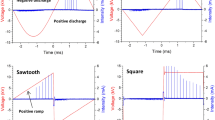Abstract
We investigated nitrogen monoxide, nitrogen dioxide and ozone generation for corona-like dielectric barrier discharge in a stationary magnetic field with airflow. The magnetic field was produced by the permanent magnet. We showed that nitrogen monoxide could be easily generated at relatively low voltages, by application of a magnetic field on the hollow needle to mesh with a dielectric barrier discharge. For higher voltages generation of nitrogen monoxide falls to zero, and generation of nitrogen dioxide and ozone with increasing voltage increases. We also demonstrated that simultaneous application of the magnetic field with airflow through the needle electrode affects the transition of the discharge from the high to the low voltage regime. This transition is accompanied by important changes in the production of nitrogen oxides and ozone. Changes in the discharge regime are reflected by changes in the voltage–current waveforms. The obtained results could be interesting for various biomedical applications or bacterial decontamination of surfaces.

















Similar content being viewed by others
References
Malik MA (2016) Plasma Chem Plasma Process 36:737–766
Sysolyatina E, Mukhachev A, Yurova M, Grushin M, Karalnik V, Petryakov A, Trushkin N, Ermolaeva S, Akishev Y (2014) Plasma Process Polym 11:315–334
Janda M, Martišovitš V, Hensel K, Machala Z (2016) Plasma Chem Plasma Process 36:767–781
Malik MA, Schoenbach KH, Heller R (2014) Chem Eng J 256:222–229
Pekárek S, Rosenkranz J (2002) Ozone Sci Eng 24:221–226
Pekárek S (2011) Eur Phys J D 61:657–662
Jodzis S (2003) Ozone Sci Eng 25:63–72
Yuan D, Wang Z, Ding C, He Y, Whiddon R, Cen K (2016) J Phys D Appl Phys 49:455203. doi:10.1088/0022-3727/49/45/455203
Akishev Y, Demyanov A, Karalnik V, Monich A, Trushkin N (2003) Plasma Phys Rep 29:82–91
Petit M, Goldman A, Goldman M (2002) J Phys D Appl Phys 35:2969–2977
Lee YH (2005) J Korean Phys Soc 47:74–78
Ghasemi M, Sohbatzadeh F, Mirzanejhad S (2015) J Theor Appl Phys 9:177–183
Park JY, Kim GH, Kim JD, Koh HS, Lee DC (1998) Combust Sci Technol 133:65
Hao X, Mattson AM, Edelblute ChM, Malik MA, Heller LC, Kolb JF (2014) Plasma Process Polym 11:1044–1056
Kitayama J, Kuzumoto M (1999) J Phys D Appl Phys 32:3032–3040
Pekárek S (2013) J Phys D Appl Phys 46: 505207 (9 pp) doi:10.1088/0022-3727/46/50/505207
He Z, Yu F, Hu F, Yuan Y, Guo L, Li J (2007) Appl Plasma Sci Technol 9:706–708
Pekárek S (2012) J Phys D Appl Phys 45:075201. doi:10.1088/0022-3727/45/7/075201
Kogelschatz U, Eliason B, Hirch M (1988) Ozone Sci Eng 10:367–378
Yagi S, Tanaka M (1979) J Phys D Appl Phys 12:1509–1520
Abdelaziz AA, Ishijima T, Seto T, Osawa N, Wedaa H, Otani Y (2016) Plasma Sour Sci Technol 25:035012. doi:10.1088/0963-0252/25/3/035012
Fridman A (2008) Plasma chemistry. Cambridge University Press, New York
Becker KH, Kogelschatz U, Schoenbach KH, Barker RJ (2005) Non-equilibrium air plasmas at atmospheric pressure. IOP Publishing Ltd, Briston
deB B, Darwent B (1970) NSRDS—NBS 31
Cheremisinoff PN (1977) Air pollution control and design handbook, Part 2, July 1
Zeldovich YB, Sadonikov PY, Frank-Kamenetskii DA (1947) Oxidation of Nitrogen in combustion. Academy of Science USSR Institute of Chemical Physics, Moscow-Leningrad
Acknowledgement
This research has been supported by the Czech Science Foundation Grant Under Contract No. 17-19968S. The author would also like to thank Mr. P. Neugebauer for taking the photograph of the discharge.
Author information
Authors and Affiliations
Corresponding author
Rights and permissions
About this article
Cite this article
Pekárek, S. Experimental Study of Nitrogen Oxides and Ozone Generation by Corona-Like Dielectric Barrier Discharge with Airflow in a Magnetic Field. Plasma Chem Plasma Process 37, 1313–1330 (2017). https://doi.org/10.1007/s11090-017-9831-9
Received:
Accepted:
Published:
Issue Date:
DOI: https://doi.org/10.1007/s11090-017-9831-9




